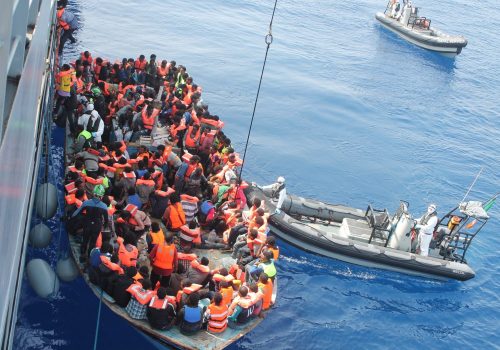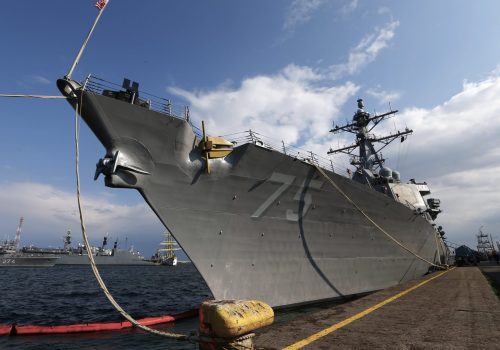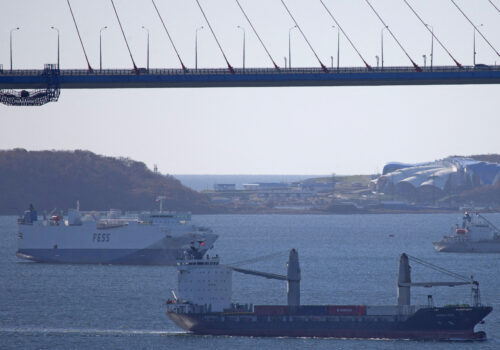NATO should be ambitious with its new Southern Flank Strategy
When the leaders of NATO member states gather for the Alliance’s seventy-fifth anniversary summit in Washington in July, they will have several high-profile items on the agenda. Russia’s war on Ukraine and NATO members’ aid for Ukraine will almost certainly dominate discussions. However, there is another item on the agenda that has not received as much attention in the press as it should: NATO is scheduled to adopt its first ever Southern Flank Strategy at the Washington summit.
Despite the critical importance of the Ukraine War for the Alliance, several NATO members are also concerned about instability on the Alliance’s Southern Flank, which in the Alliance’s parlance refers to the Middle East and North Africa (MENA), the Sahel, and the Mediterranean Sea that links those areas to allies’ shores.
Allies will, however, face significant challenges in adopting a meaningful Southern Flank Strategy, because allies differ on threat assessments and hold varied views on the Alliance’s scope. There are also limits to NATO’s capacity. NATO leaders may ultimately agree on a consequential Southern Flank Strategy at the Washington summit, but it is not a foregone conclusion.
Why NATO’s Southern Flank matters now
The underlying problem with the Southern Flank is instability in the region, which is rooted in political, security, economic, and demographic problems that are exacerbated by climate change.
This instability on the Alliance’s Southern Flank has important consequences for NATO members. The International Organization for Migration’s data suggests that 286,122 people migrated to Europe in 2023, a significant increase from the 189,620 who migrated in 2022 and 151,417 in 2021. In recent years, a few terrorist acts in Europe have involved migrants staying illegally on the continent, sparking broader security concerns. Large-scale irregular migration also brings with it concerns over the trafficking of humans and contraband substances, and other illegal activities.
Instability on the Alliance’s Southern Flank also has economic consequences. Since Russia’s full-scale invasion of Ukraine in 2022, Europe has decreased oil and gas imports from Russia and increased imports from the MENA region. As of the last quarter of 2023, the European Union (EU) imported 21 percent of its oil from three MENA countries: Libya, Saudi Arabia, and Iraq. The EU also imported 17.8 percent of its gaseous-state natural gas from Algeria and 24.1 percent of its liquefied natural gas from Libya and Qatar. Instability on NATO’s Southern Flank is also a potential threat to the maritime commerce that flows through the Mediterranean Sea, which accounts for 15 percent of the world’s shipping by port calls and 10 percent of the world’s shipping by vessel weight.
Russia’s behavior in the MENA region and the Sahel is another reason why NATO needs to take the Southern Flank seriously. The Wagner Group, which the United States has labeled a proxy of the Kremlin, has a significant presence in Libya, Mali, and Sudan. Wagner provides thousands of mercenary troops, weapons, and training in these countries and Russia undoubtedly gains significant political influence with the host governments. Recent reporting suggests that Russia may directly take over Wagner activities with an “Africa Corps” that will man a network of Russian bases on the continent. Russia also has a naval base in Tartus, Syria—home to its Mediterranean Squadron, which includes Kilo-class submarines, a cruiser, and a frigate. In 2023, Spanish and Italian navies reported incidents of the Russian frigate Admiral Kasatonov sailing with a Russian tanker in the Mediterranean. Russia’s naval presence in the Mediterranean could be used for offensive, defensive, or hybrid operations against members of the Alliance or their interests.
Challenges in developing a Southern Flank Strategy
One significant challenge facing the development of a meaningful Southern Flank Strategy is the differing threat perceptions of leading NATO members.
On the one hand, NATO members along the Alliance’s Southern Flank view instability there as a security concern and a domestic political imperative. Italy and Spain, for example, see instability in the Mediterranean as a direct threat to their security. Italian Prime Minister Giorgia Meloni, in her press conference after NATO’s 2023 Vilnius summit, stressed Italy’s role in getting allies to agree to develop a Southern Flank Strategy in 2024. Meloni referred to herself as the “bearer” of the view that problems on the Southern Flank are not just Italy’s problem, but NATO’s as well. She went on to say that the Alliance’s “greater awareness” of the Southern Flank was “due to Italy.”
On the other hand, nearly two years since Russia’s full-scale invasion of Ukraine, NATO’s Eastern Flank members continue to focus on the threat that the Kremlin poses to their security. Given the urgency of the Russian threat and the limited resources available, it is understandable for Eastern Flank members to worry that any new significant NATO activities in the south could draw resources away from the defense of the Alliance’s eastern border.
The second challenge facing the development of a Southern Flank Strategy is a fundamental difference in views on NATO’s mission and scope. Some members take an expansive view that NATO should act to help allies address their security concerns without limits to the nature of activities or geographical space. Others, most vocally France, argue NATO should focus primarily—even exclusively—on territorial defense. France’s view has grown stronger since Russia’s 2022 invasion of Ukraine. Policymakers in Paris have come to recognize the urgency of the threat Russia poses and the lack of an alternative to NATO in terms of territorial defense. France’s 2022 National Strategic Review, for example, says that “Russia is pursuing a strategy that seeks to undermine European security, of which the war against Ukraine, is the most open and brutal manifestation.” It goes on to say that “NATO is still the foundation and essential framework for Europe’s collective security.” France’s views on what NATO should do suggest that it will resist any moves to expand NATO’s remit on the Southern Flank.
The final challenge has to do with NATO’s limits relative to the challenges facing the Southern Flank. Leaving aside debates about what NATO should and should not do, it is fundamentally a military alliance. As such, it lacks certain capabilities that are necessary in improving the conditions on the Alliance’s Southern Flank. NATO, for example, lacks the capacity to engage in any significant economic development activities. It is also not well equipped to engage in activities to strengthen democracy or the rule of law in the countries along its Southern Flank. Finally, NATO faces limits in terms of its image in the region that would put it at a disadvantage if it were to engage in any high-profile, public-facing activities.
Prospects for the Washington summit
There are two basic possibilities for the Washington summit: an embrace of the status quo or a more ambitious attempt to confront the challenges allies on the Southern Flank face.
Given the challenges, under the most likely scenario, the Alliance might enhance existing intelligence gathering and sharing activities. The Southern Flank Strategy could also commit to a marginal increase in the Alliance’s maritime security operations under Operation Sea Guardian in the Mediterranean. Finally, the Southern Flank Strategy could entail a commitment to deepen cooperation with regional partners through the Mediterranean Dialogue and the Istanbul Cooperation Initiative.
But what might a more ambitious and consequential Southern Flank Strategy look like? First, NATO could engage in a significant increase in counterterrorism training and assistance with regional partners. Second, NATO could better prepare for future military operations in the region by engaging in additional advanced planning and by establishing a multinational division for the Southern Flank. Third, NATO could agree to significantly enhance the resources for Operation Sea Guardian, allowing for more maritime situational awareness, more maritime counterterrorism, and, especially, more maritime security capacity building with regional partners. Finally, NATO could commit to coordinating its activities with the EU and support and encourage the bloc’s efforts to address the Southern Flank’s economic and political challenges.
While a status quo scenario, perhaps with some additions, is most likely to emerge as the new Southern Flank Strategy at the Washington summit, a more ambitious approach, like the one outlined above, would be a better choice for the Alliance.
First, the more ambitious approach would be more likely to stabilize the Alliance’s Southern Flank—a problem that ultimately matters for all members of the Alliance. Second, by embracing an ambitious Southern Flank Strategy, NATO would demonstrate that it is sensitive to the concerns of all members, not just those most concerned with the threat Russia poses. Such a move would reward those Southern Flank allies, such as Italy, that have sent troops to bolster the Eastern Flank and have borne significant economic costs because of sanctions on Russia. An ambitious approach to the Southern Flank would be politically popular in the Southern Flank countries, as well, allowing governments to tout the benefits of their country’s membership in NATO.
The United States has the outsized leverage in the Alliance to overcome those who might resist an ambitious strategy. It also does not have any obvious reasons to oppose it. What remains to be seen is whether it will recognize the benefits of a bold Southern Flank Strategy and exert its influence accordingly at the upcoming summit.
Jason W. Davidson is a professor of political science at the University of Mary Washington and a nonresident senior fellow at the Atlantic Council’s Transatlantic Security Initiative within the Scowcroft Center for Strategy and Security. He is the author of America’s Entangling Alliances: 1778 to the Present (Georgetown University Press) and is currently completing a book on NATO after the Ukraine War.
Further reading
Thu, Aug 3, 2023
Irregular migration from North Africa: Shifting local and regional dynamics
Report By
Irregular migration from North Africa to Europe, especially through the Central Mediterranean route connecting Libya and Tunisia to Italy, is increasing once more. Italy has witnessed a surge in irregular arrivals, with approximately 136,000 migrants disembarking between June 2022 and May 2023, almost comparable to the high arrival period of 2014-2017 when around 155,000 migrants landed each year.
Fri, Dec 15, 2023
A security strategy for the Black Sea
Report By
This report outlines the strategic setting, regional challenges and threats, key planning assumptions, risk and risk mitigation, and finally DIME (diplomatic, informational, military, and economic) based recommendations for enhancing security and stability in the Black Sea region.
Thu, Jan 11, 2024
Russia’s growing dark fleet: Risks for the global maritime order
Issue Brief By Elisabeth Braw
Russia's dark fleet poses a significant threat to maritime security, forming the basis of Moscow's grayzone aggression against Western institutions.
Image: Ships from multiple NATO nations including Italy, Spain, Germany, the United States, and the United Kingdom, participate in Exercise Mare Aperto 22-2, a high-end exercise sponsored by the Italian Navy aimed at strengthening and enhancing the combat readiness of participating assets in the conduct of maritime operations. Forrest Sherman (DDG 98) is the flagship for Standing NATO Maritime Group Two (SNMG2), a multinational integrated task group that projects a constant and visible reminder of the Alliance’s solidarity and cohesion afloat and provides the Alliance with a continuous maritime capability to perform a wide range of tasks, including exercises and real-world operations in periods of crisis and conflict. (U.S. Navy Photo by Mass Communication Specialist 2nd Class Ezekiel Duran, October 11, 2022)


